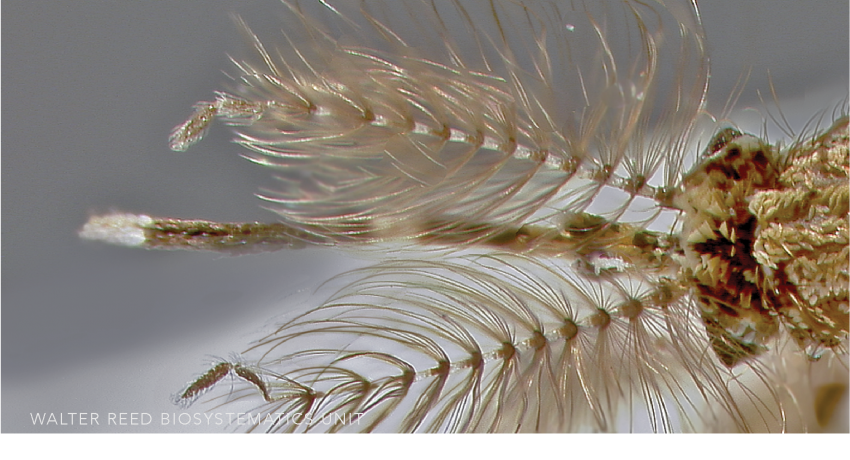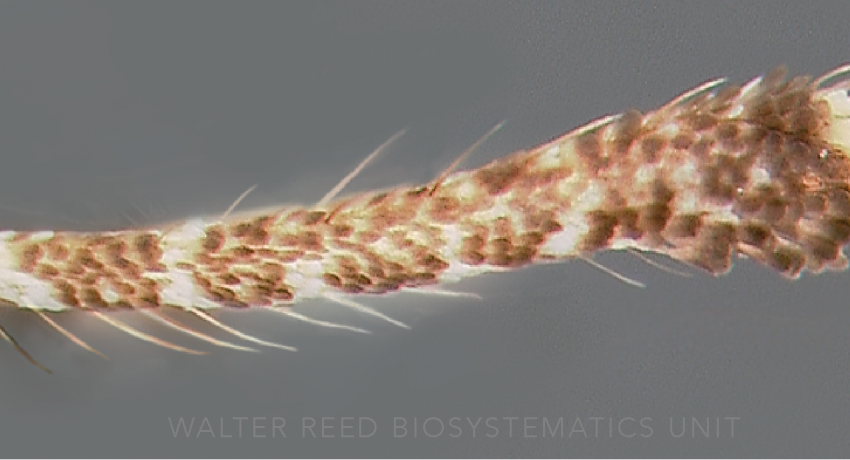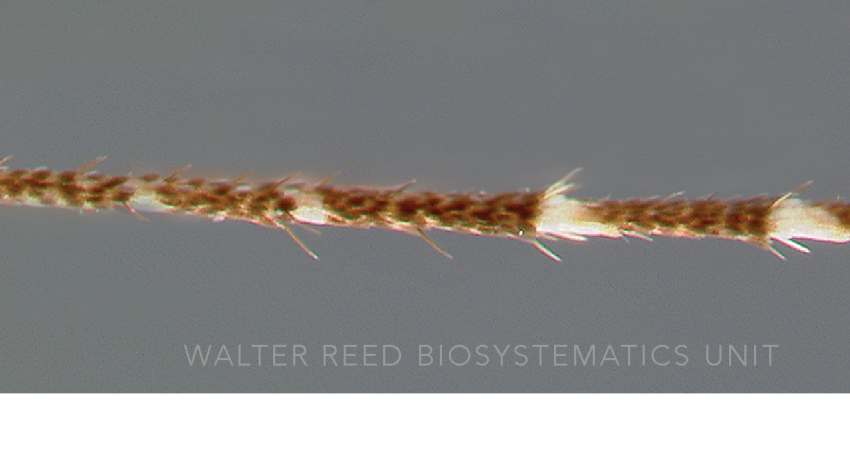AFROTROPICAL, AUSTRALASIAN, NEARCTIC, NEOTROPICAL, & ORIENTAL REGIONS
Generic abbreviation: Ad.
Type species: Aedes squamipenna Lynch Arribálzaga. Brunetti 1914: 54 (type species design.).
Etymology: n.s. [aedeo- bashful, shy & -myia fly (Gr)].
Species of the genus Aedeomyia are covered with broad scales and superficially resemble mosquitoes of the Tribe Aedini, except that all antennal flagellomeres in females, and the apical two flagellomeres of the males are uniquely stout. Larval antennae are also notably swollen, strongly curved and longer than the head capsule. Aedeomyia squamipennis (Lynch Arribálzaga) serves as the type species for the genus. Aedeomyia comprises only seven species, further subdivided into two subgenera: six in the subgenus Aedeomyia [Ad. africana Neveu-Lemaire, Ad. catasticta Knab, Ad. madagascarica Brunhes, Boussès & da Cunha Ramos, Ad. pauliani Grjebine, Ad. squamipennis (Lynch Arribálzaga) and Ad. venustipes (Skuse)], and only one species is placed in the subgenus Lepiothauma—Ad. furfurea (Enderlein). Aedeomyia is the only genus within the Tribe Aedeomyiini, and, despite the paucity of representative taxa, has a remarkably wide distribution.
DIAGNOSTIC CHARACTERS (Click photos to view; mouse over and click large photo to zoom in.)
ADULT (illustrated): Head: Broad scales on pedicel, Flm1 and clypeus in ♀; Flm12,13 elongate in ♂. Thorax: Lower mesepimeral setae present; prespiracular and postspiracular setae absent. Leg: Fe-II,III with large apical scale tufts; Ta-III1 longer than Ta-III2–5 combined. Wing: Dense covering of broad white, yellow and brown scales.
LARVA (not illustrated): Head: Antennae swollen, strongly curved, longer than the head. Thorax: Setae 9,10-P,M,T usually very long. Terminal segments: Pecten absent; siphon uniformly pubescent; pair of curved hooks and a pair of many-branched setae at apex; siphonal trachea reduced; comb scales in a single row on small sclerotized plate.
TAXONOMIC KEYS
Edwards 1929c
Tyson 1970a
Rattanarithikul & Harrison et al. 2005
Rattanarithikul et al. 2006b
Brunhes et al. 2011
![]()
WRBU – Genera – Global – Larva
![]()
WRBU – Genera – Afrotropical – Adult
![]()
WRBU – Genera – Afrotropical – Larva
![]()
WRBU – Genera – Australasia – Adult
![]()
WRBU – Genera – Australasia – Larva
![]()
WRBU – Genera – IndoMalaya – Adult
![]()
WRBU – Genera – IndoMalaya – Larva
![]()
WRBU – Genera – Neotropical – Adult
![]()
WRBU – Genera – Neotropical – Larva
![]()
WRBU – Genera – Oriental – Adult
![]()
WRBU – Genera – Oriental – Larva
Exemplar DNA sequences
Ad. squamipennis whole mitochondrial genome: NC_044647; MK575473
Ad. africana COI: KU186980-82,85
Ad. catasticta COI: AY729969
Ad. furfurea COI: KU186979, KU186983-84, KU186986
BIONOMICS
Immatures
When threatened, Aedeomyia larvae remain submerged for long periods, possibly using their enlarged antennae for cuticular respiration. Immature Ad. (Lep.) furfurea are typically found in large densely vegetated swamps or ponds, especially those with water lettuce (Pistia spp.), but have been reported in mature rice fields in Madagascar.
Adults
Adult Aedeomyia are most active after sunset, and feed primarily in birds in the forest canopy. Aedeomyia (Aed.) africana and Ad. (Lep.) furfurea females are highly attracted to human bait in the canopy and will opportunistically attack people passing at ground level. In Thailand, Ad. (Aed.) catasticta often bites man, and several arboviruses have been recovered from this species and from Ad. squamipennis.
*Associated pathogens: This list reports bacteria, viruses, and parasites recovered from, or experimentally passed through this species, and does not imply field vector status.
IMPORTANT REFERENCES (full citations below)
Theobald, 1901b: 235 (as genus, subgenus)
Theobald, 1901a: 98 (as genus, subgenus)
Theobald, 1901c: 218 (as genus, subgenus)
Giles 1902: 475, 478 (unjustified emendment to Aedomyia)
Edwards 1929c: 326 (as Aedomyia, key)
Mackerras 1937 (as Aedomyia, taxonomy)
Lane 1953 (Neotropics)
Thurman 1959b: 60 (as Aedeomyia without comment);
Belkin 1962: 273 (taxonomy Aedomyia, invalid emendment; South Pacific)
Tyson 1970a: 1 (F, P, L; keys, revision)
da Cunha Ramos & Ribeiro 1975 (L; distribution; Angola)
Lee et al. 1982: 1-15 (taxonomy; Australasian region)
Service 1990 (L; bionomics, taxonomy, distribution; Africa)
Rattanarithikul & Harrison et al. 2005 (F, L; tax. keys, bionomics; Thailand)
Rattanarithikul et al. 2006b (F, L; keys, distribution; Thailand)
Brunhes et al. 2011 (genus & subgeneric description; key)
VALID SUBGENERA
Aedeomyia Theobald [Ady.]
Lepiothauma Enderlein [Lpi.]
CURRENT GENERIC SYNONYMS
syn. Aedomyia Giles 1902: 478 (emendment)
CITED REFERENCES
Belkin, J.N. (1962). The mosquitoes of the South Pacific (Diptera, Culicidae) (Vols. 1 &2). Berkeley, California: University of California Press.
Brunhes, J., Boussès, P., & da Cunha Ramos, H. (2011). Les Aedeomyia Theobald, 1901, des régions afro-tropicale et malgache (Diptera, Culicidae). Bulletin de la Société Entomologique de France, 116(1), 99–128.
da Cunha Ramos, H., & Ribeiro, H. (1975). Research on the mosquitoes of Angola (Diptera: Culicidae). IX - Genera Toxorhynchites Theo., 1901, Malaya Leicester, 1908, Ficalbia Theo., 1903, Coquillettidia Dyar, 1905, Mansonia Blanchard, 1901, Uranotaenia L. Arribalzaga, 1891, Aedeomyia Theo., 1901, Eretmapodites Theo., 1901 and Culiseta Felt, 1904. Anais do Instituto de Higiene e Medicina Tropical, 2(1–4), 111–141.
Edwards, F.W. (1929c). Mosquito notes. VIII. Bulletin of Entomological Research, 20, 321–343.
Giles, G.M. (1902). A handbook of the gnats or mosquitoes giving the anatomy and life history of the Culicidae, together with descriptions of all species notices up to the present date. J. Bale, sons & Danielsson, Limited, London, 530pp.
Lane, J. (1953). Neotropical Culicidae (Vols. I, II). São Paulo: University of São Paulo.
Lee, D.J., Hicks, M.M., Griffiths, M., Russell, R.C., & Marks, E.N. (1982). The Culicidae of the Australasian region. Volume 2. Commonwealth Department of Health, School of Public Health and Tropical Medicine Monograph Series, 2.
Mackerras, I.M. (1937). Notes on Australian mosquitoes (Diptera, Culicidae). III. The genus Aedomyia Theobald. Proceedings of the Linnean Society of New South Wales, 62, 259–262.
Rattanarithikul, R., Harrison, B.A., Harbach, R.E., Panthusiri, P., & Coleman, R.E. (2006b). Illustrated keys to the mosquitoes of Thailand. IV. Anopheles. Southeast Asian Journal of Tropical Medicine and Public Health, 128(Supplement 2), 2.
Rattanarithikul, R., Harrison, B.A., Panthusiri, P., & Coleman, R.E. (2005). Illustrated keys to the mosquitoes of Thailand. I. Background; geographic distribution; lists of genera, subgenera, and species; and a key to the genera. Southeast Asian Journal of Tropical Medicine and Public Health, 36(1), 1–80.
Service, M.W. (1990). Handbook to the Afrotropical toxorhynchitine and culicine mosquitoes, excepting Aedes and Culex. British Museum (Natural History).
Theobald, F.V. (1901a). A monograph of the Culicidae or mosquitoes (Vol. 1). London: British Museum (Natural History). [424pp]
Theobald, F.V. (1901b). The classification of mosquitoes. Journal of Tropical Medicine, 4, 229–235.
Theobald, F.V. (1901c). A monograph of the Culicidae or mosquitoes (Vol. 2). London: British Museum (Natural History). with Atlas of 37 colored pls. + 5 pls. of photographs.
Thurman, E.B. (1959b). A contribution to a revision of the Culicidae of northern Thailand. Bulletin of the University of Maryland Agriculture Experimental Station A, 100, 1–177.
Tyson, W.H. (1970a). Contributions to the mosquito fauna of Southeast Asia. VII. Genus Aedeomyia Theobald in Southeast Asia. Contributions of the American Entomological Institute, 6(2), 1–27.
CITE THIS PAGE
Walter Reed Biosystematics Unit (Year). Aedeomyia genus page. Walter Reed Biosystematics Unit Website, http://wrbu.si.edu/vectorspecies/genera/aedeomyia, accessed on [date (e.g. 03 February 2020) when you last viewed the site].








